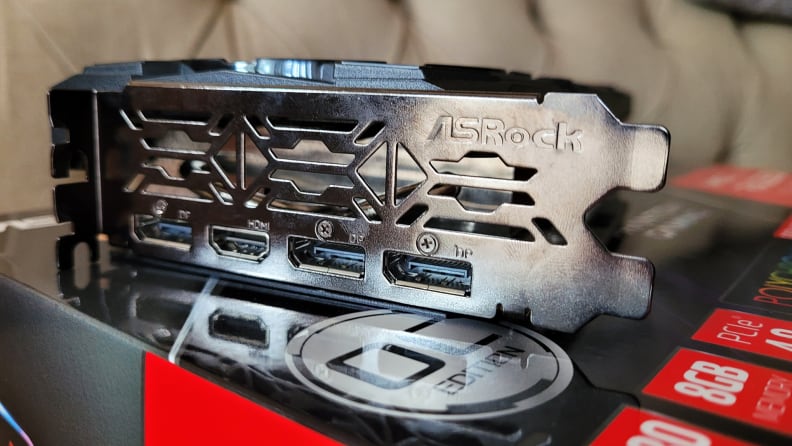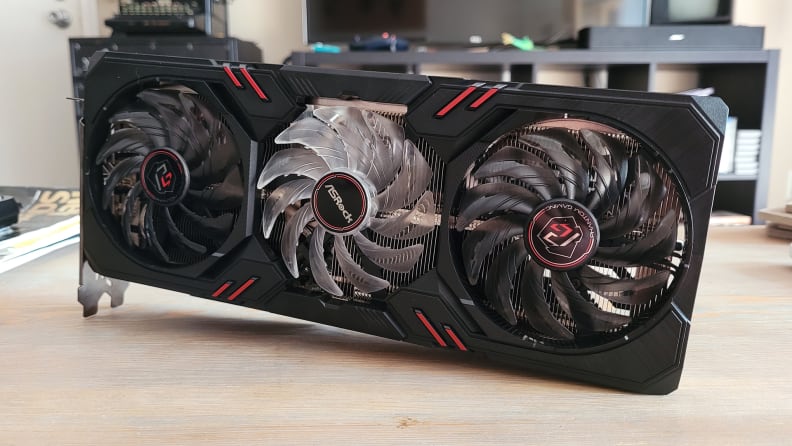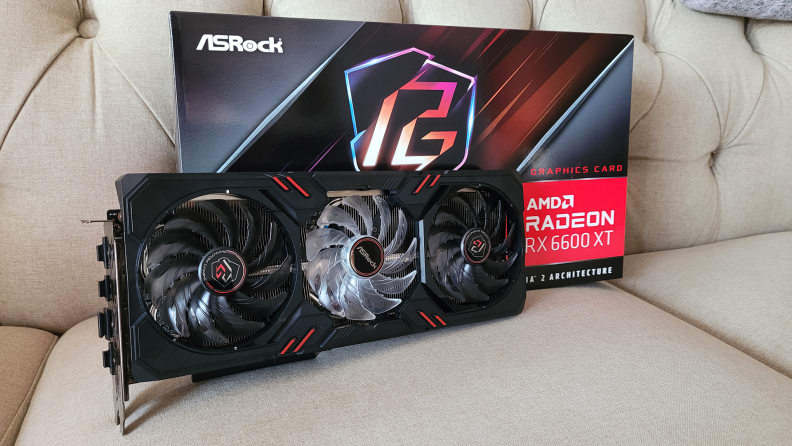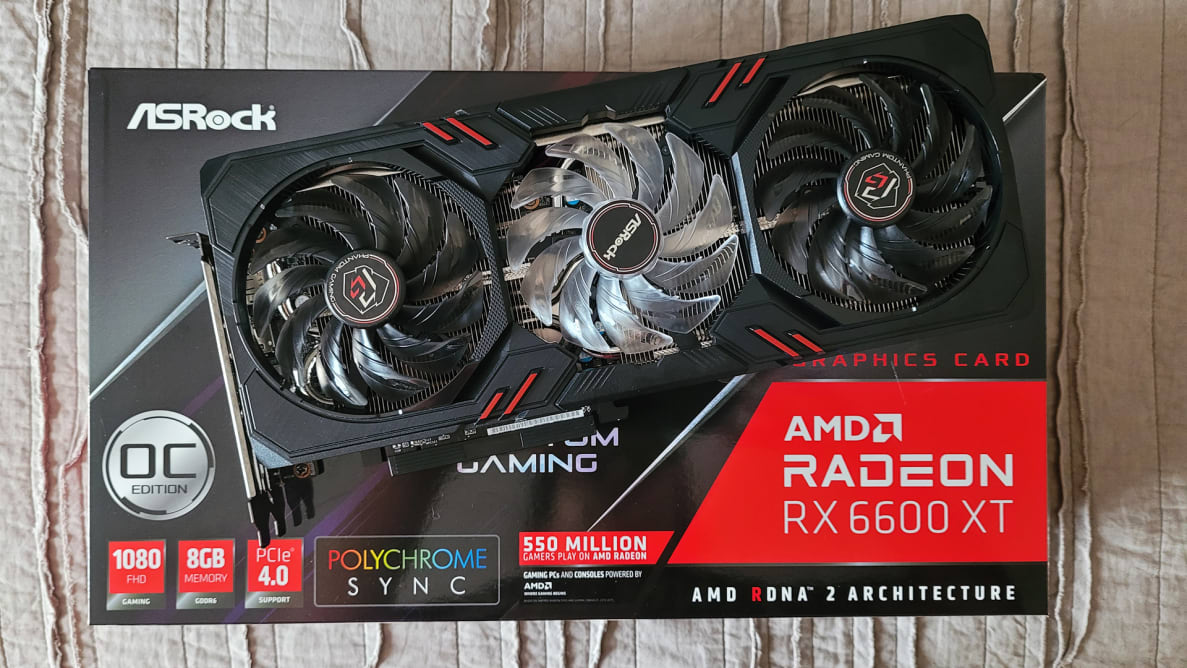Pros
-
Great for 1080p gaming
-
Surprisingly good 1440p performance
Cons
-
Poor ray tracing performance
-
Not a great value
About the ASRock AMD Radeon RX 6600 XT Phantom Gaming 8GB OC Edition
These are the specs of the GPU we tested:
- Compute units: 32
- Base frequency: 2428 MHz
- Boost frequency: Up to 2607 MHz
- Game frequency: 2359 MHz
- Ray Accelerators: 32
- Stream Processors: 2048
- Texture Units: 128
- Power requirement: 160 W
- Infinity Cache: 32 MB
- Memory Speed: 16 Gbps
- Max Memory Size: 8 GB
- Memory Type: GDDR6
- Memory Interface: 128-bit
- Memory Bandwidth: Up to 256 GB/s
Graphics card specs may seem like a bunch of technobabble, but some of the key things you’ll want to pay attention to in the case of the Radeon RX 6600 XT include the Infinity Cache, Ray Accelerators, and Memory Interface, which we cover in our review.
Aside from raw frequency, these are three main aspects of AMD’s RDNA2 architecture (which powers all RX 6000-series GPUs) that will give you an idea about how it will perform compared to other graphics cards in the field, not necessarily what's available at the moment given the on-going GPU shortage.
For our GPU tests, we used the following desktop PC configuration:
- Processor: AMD Ryzen 9 5950X
- Motherboard: Asus ROG Maximus Extreme XII X570
- Memory: G.Skill Trident Z Royal 16 GB (2 x 8 GB) DDR4-3600 MHz
- Storage: Samsung 970 NVMe M.2 500GB SSD
- Power: Seasonic Focus GX-1000
- Cooling: Corsair H150i Pro RGB
What we like
Infinity Cache boosts frame rates

This RX 6600 XT has three DisplayPort connections and one HDMI connection.
AMD uses something it calls Infinity Cache to help increase frame rate speeds with its Radeon RX 6000-series graphics cards. It does this by storing certain visual data on the cache so the main GPU cores can access and load that data faster.
Normally, a shader (which allows a GPU to manipulate an image before it appears on-screen) will access the same visual data more than once for multiple frames. Because the GPU needs to access the same data over and over again, this can result in a lower frame rate because the card is taking longer to access that information. What Infinity Cache does is create extra, temporary storage that reuses all that data when rendering a complex image. It recognizes what visual data it needs to access most frequently and stores it right next to the main GPU cores for quick, easy access.
Because of this difference in architecture, AMD Radeon RX 6000-series cards generally net the same or more frames than equivalent Nvidia RTX 30-series cards. The RX 6600 XT sits in between Nvidia’s RTX 3060 Ti and RTX 3060 despite having a slightly smaller memory interface than the RTX 3060. This remained consistent across all 12 games we tested at the highest graphics preset on 1080p thanks to that 32MB of cache.
The RX 6600 XT averaged 104 frames per second while the RTX 3060 Ti averaged 118 fps. That’s only a 14 fps increase over the RX 6600 XT despite the RTX 3060 Ti having a memory interface double the size of the AMD card. The larger the memory interface, the more data that can travel through it at the same time—but since Infinity Cache works to increase rendering speeds while keeping power consumption low, the RX 6600 XT doesn’t need a larger memory interface to keep pace with Nvidia’s RTX 3060 Ti, or even the RTX 3060.
(Note: With the RX 6600 XT, graphically demanding games like Metro Exodus, Contol, and Cyberpunk2077, will net between 70-85 fps, while games like Far Cry 5, Shadow of the Tomb Raider, and Forza Horizon 4, all break 100 easily.)
The difference between the RX 6600 XT and RTX 3060 is even less pronounced, however, with the AMD card averaging only 6 fps more than the Nvidia card. (More on that in a bit.) Those two cards have memory interfaces that are nearly the same size, with the AMD GPU being the smaller of the two, but again, AMD’s Infinity Cache is what helps it keep up with the RTX 3060 despite its larger memory interface.
Surprsing 1440p performance

The RX 6600 XT reviewed here is a triple fan GPU.
AMD says its newest budget GPU is ideal for 1080p gaming, but its overall performance pumps out good 1440p performance in certain games, too. Aside from Metro Exodus, Cyberpunk 2077, and Control, all games averaged 62 fps and higher at 1440p on the highest graphics preset.
Far Cry 5, Forza Horizon 4, and Battlefield V, were among the highest 1440p performing titles at 104, 132, and 137 fps, respectively. But again, this is with the graphics maxed-out, so there’s a lot of headroom to bump up those frame rates on more graphically demanding games if you set the graphics preset lower.
The RX 6600 XT also blows past the RTX 3060 at 1440p—by a significant amount. On average, AMD’s card puts out 10-25 more frames a second compared to Nvidia’s, with the largest difference seen in games like Far Cry 5, Assassians Creed Odyssey, Forza Horizon 4, Borderlands 3, and Battlefield V.
What we don’t like
Ray tracing performance is low

Unfortunately, the RX 6600 XT can't outpace the RTX 3060's ray tracing performance.
Ray-tracing, or realistic lighting effects rendered in real-time, is part of all current-gen discrete graphics cards these days. Nvidia first introduced the feature near the end of 2018 with its RTX 20-series cards, while AMD played catch-up with its current gen. However, if we look at AMD’s RDNA2 architecture and how it handles ray tracing, it’s not surprising that the RX 6600 XT suffers in the same way the higher-end RX 6000-series cards do.
AMD combines its ray-tracing cores, or what it calls ray accelerators, with the larger compute units (main GPU cores) on its current-gen graphics cards. Because of this, the compute units and ray accelerators have to share bandwidth, while Nvidia’s GPUs are more efficient at ray tracing effects because it keeps the cores that process those visuals separate from its CUDA cores, or main cores.
For instance, with ray tracing on at the highest graphics preset at a 1080p resolution, the RX 6600 XT averages 38 fps in_Control_, 19 fps in Cyberpunk 2077, and 52 fps in Metro Exodus. The RTX 3060 nets 48 fps in Control, 39 fps in Cyberpunk, and 55 fps in Metro Exodus. Like its siblings, the RTX 3060 is the ray-tracing winner here, even at an MSRP that’s $50 less than the RX 6600 XT.
For (theoretically) $20 more, you can get the RTX 3060 Ti with ray tracing performance that’s around 10-20 fps more than the RX 6600 XT at a 1080p resolution. If you could get a hold of one, that is.
Mediocre value

The RX 6600 XT's non-ray tracing performance is near-equivilant to Nvidia's RTX 3060.
The RX 6600 XT is supposed to cost around $379, but GPU pricing is bananas at the moment due to the ongoing chip shortage and sky-high resale prices (thanks, scalpers). This makes it hard to accurately determine overall value because resellers on eBay usually charge wildly different prices. However, when we look at the RX 6600 XT’s performance compared to its MSRP and the competition, it’s not a compelling alternative to Nvidia’s RTX 3060.
The RTX 3060 is supposed to cost $329, and yet its average 1080p performance is only six frames behind the RX 6600 XT. (If the 6600 XT had more Infinity Cache, the gap between the two would possibly be much larger.)
The RTX 3060 is still miles ahead of the RX 6600 XT in ray tracing performance thanks to the dedicated ray-tracing (RT) cores in Nvidia’s RTX 30-series cards. If you can find an RTX 3060 for less than an RX 6600 XT, the RTX 3060 is the clear winner here.
Whatsmore, to get near-equivalent performance to an RTX 3060 Ti, you’d need to step up to a Radeon RX 6700 XT and spend $100 more at MSRP.
Should you buy it?
Maybe, if you can’t find a cheaper GPU

The RX 6600 XT works best for 1080p gaming.
The RX 6600XT would have made up for its ray-tracing shortcomings if its standard gaming performance wasn’t near-equivalent to the RTX 3060. Had AMD included more than 32MB of Infinity Cache or gone for a larger memory interface, the RX 6600 XT would probably be worth the extra $50 over the RTX 3060’s MSRP. (AMD’s higher-end RX 6000-series cards pack in the cache, so something like the Radeon RX 6800 XT can outperform the RTX 3080 in a lot of games, sans ray-tracing.)
Given the current graphics card situation, we can’t blame anyone who just wants any graphics card, but regardless of the amount you pay for one, you’ll get a better deal with anything other than an RX 6600 XT—especially since the card we tested for this review is an overclocked edition, which means it runs at a higher frequency out the box for better frame rates. If this is what the RX 6600 XT gets when it’s overclocked, its stock performance is likely lower than the RTX 3060.
Normally, we’d recommend ray tracing enthusiasts to go with Nvidia, while esports fanatics go with AMD—but the RTX 3060 remains the better all-around choice at this price point. If the RTX 3060 is too slow for you, the RTX 3060 Ti is an even better alternative, with an MSRP that’s only $20 more than the RX 6600 XT and performance that puts it to shame. Again, retail and third-party seller prices will likely be much higher than MSRP, but your money goes further with an Nvidia card compared to the RX 6600 XT.
Meet the tester
Joanna specializes in anything and everything gaming-related and loves nerding out over graphics cards, processors, and chip architecture. Previously she was a staff writer for Gizmodo, PC Gamer, and Maximum PC.
Checking our work.
Our team is here to help you buy the best stuff and love what you own. Our writers, editors, and experts obsess over the products we cover to make sure you're confident and satisfied. Have a different opinion about something we recommend? Email us and we'll compare notes.
Shoot us an email



